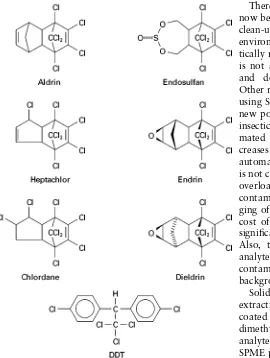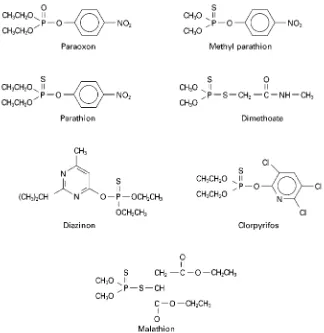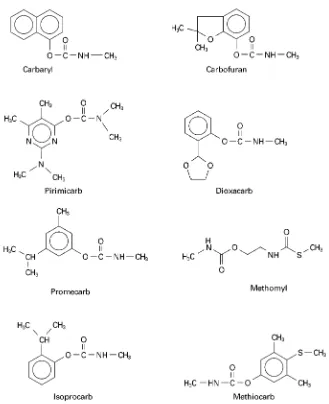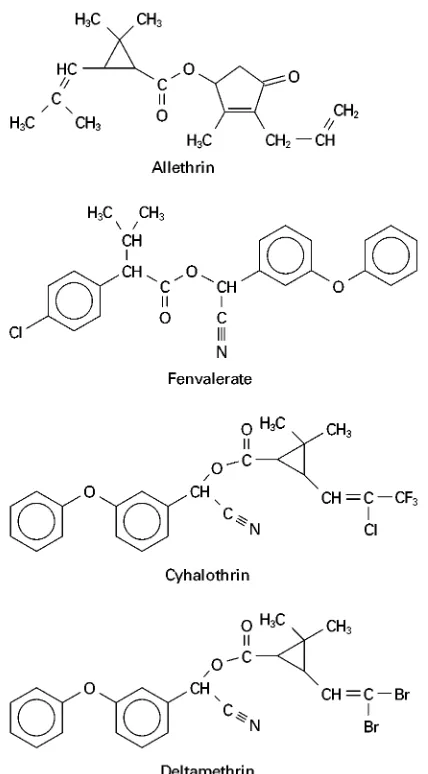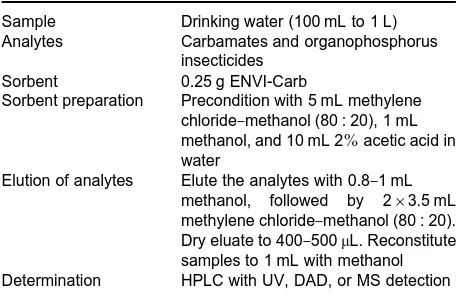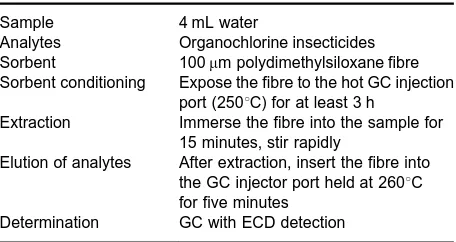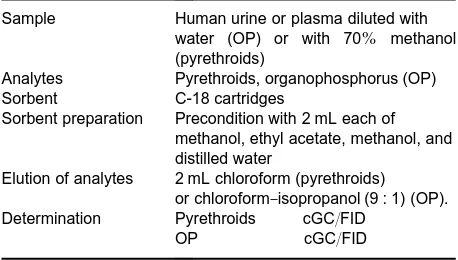Supercritical Suid extraction is making slow pro-gress, probably because of its high cost compared to traditional extraction methods, Perhaps eventually the gas chromatograph will control the extraction and clean-up of its own samples, recording all steps with a thorough audit trail. Trends in insecticide analysis will also depend on what new classes of compounds are approaching commercial use. Ele-ment-selective detectors may not be suitable, but GC-MS-MS and LC-GC-MS-MS should be able to cope with just about anything.
See also: III/Herbicides: Gas Chromatography; Solid-Phase Extraction; Thin-Layer (Planar) Chromatography. Insecticides: Solid-Phase Extraction.
Further Reading
Bottomley P and Baker PG (1984) Multi-residue determina-tion of organochlorine, organophosphorus and synthetic
pyrethroid pesticides in grain by gas-liquid and high-performance liquid chromatography. Analyst 109: 85}90.
Brown P, Charlton A, Cuthbert M, Barnett L, Green M, Gillies L, Shaw K and Fletcher M (1996) IdentiRcation of pesticide poisoning in wildlife.Journal of Chromato-graphy A754: 463}478.
Chamberlain SJ (1990) Determination of multi-pesticide residues in cereals, cereal products and animal feed using gel-permeation chromatography. Analyst 115: 1161}1165.
Cunniff P (ed.) (1995) OfTcial Methods of Analy-sis of AOAC International (16th edn). Arlington: AOAC International.
McMahon BM and Hardin NF (eds) (1994)Pesticide Ana-lytical Manual (3rd edn). USA: US Food and Drug Administration.
Meloan CE (ed.) (1996) Pesticides Laboratory Training Manual. Gaithersburg: AOAC International.
Tomlin CDS (ed.) (1999)The Pesticide Manual(11th edn). Farnham: British Crop Protection Council.
Solid-Phase Extraction
A. Przyjazny, Kettering University, Flint, MI, USA
Copyright^ 2000 Academic Press
Introduction
Synthetic insecticides represent an almost universal environmental pollutant. Chemical structures of in-secticides are very diverse, but major groups include organochlorine and organophosphorus compounds, methylcarbamates, and synthetic pyrethroids.
Organochlorine insecticides have been largely phased out of general use because of their toxicities and especially their persistence and accumulation in food chains. The structures of several common or-ganochlorine insecticides are shown inFigure 1.
Organophosphorus insecticides have largely re-placed organochlorine insecticides, because or-ganophosphorus compounds readily undergo biode-gradation and do not bioaccumulate. The structural formulas of some common organophosphorus insec-ticides are shown inFigure 2.
Carbamate insecticides are widely used for crop protection. Methylcarbamates are of environmental concern because of their high acute toxicity.Figure 3 depicts the structures of several common carbamate insecticides.
Synthetic pyrethroids have been widely produced as insecticides during recent years. They have several advantages over organochlorine and
organophos-phorus insecticides, including greater photostability, enhanced insecticidal activity, and relatively low toxicity. The structures of common pyrethroids are shown inFigure 4.
As a result of their toxicity and carcinogenicity, insecticides are hazardous to human health and life. The major route of human exposure to insecticides is the gastrointestinal system. Besides regular use of polluted water, humans eat large amounts of food in which these pollutants have been accumulated, e.g., milk and dairy products,Rsh, poultry and meat, and fruits and vegetables.
Prior to 1960, an individual analytical procedure was used for almost every insecticide. As the number of insecticides in use increased, it became impractical to apply a large number of individual methods for all the insecticides that may be present. This has led to the development of multiresidue methods for the analysis of environmental samples. Ideally, multi-residue methods should provide rapid identiRcation and quantiRcation of as many different insecti-cides as possible at the required detection level.
Figure 1 Structures of common organochlorine insecticides.
Comparison of Methods of Extraction
for Insecticides
The most difRcult and time-consuming step in the determination of insecticides in environmental sam-ples is the extraction of the analytes from the matrix. Several methods are used to accomplish this task, including liquid}liquid extraction (LLE), solid-phase extraction (SPE), solid-phase microextraction (SPME), and supercriticalSuid extraction (SFE).
Semivolatile compounds, such as insecticides, have been traditionally extracted by LLE using an organic solvent, such as methylene chloride. The main ad-vantages of LLE are its simplicity and inexpensive equipment used. The procedure suffers from a number of disadvantages, including the use of large volumes of organic solvent which must be very pure (pesticide-grade), tediousness, difRculty with automation, and the formation of emulsions which are difRcult to break. Also, the LLE is a multi-step procedure and is therefore prone to loss of analytes and/or contamination.
There is no doubt that solid-phase extraction has now become the method of choice for the extraction, clean-up, and preconcentration of insecticides from environmental, food, or biological samples. SPE dras-tically reduces amounts of organic solvents used and is not as time-consuming. It enables Reld sampling and does not suffer from emulsion problems. Other reasons for the growing number of procedures using SPE are the large choice of sorbents, including new polar sorbents capable of retaining more polar insecticides, the introduction of apparatus for auto-mated SPE, which reduces time of analysis and in-creases sample throughput, and the possibility of automation of analytical procedures. However, SPE is not completely free from problems such as column overloading by passing samples with high content of contaminants, or early breakthrough caused by clog-ging of the pores by solids present in a sample. The cost of disposable SPE cartridges or discs may be signiRcant in the case of a large number of analyses. Also, the interaction between sample matrix and analytes may result in low recoveries. SPE can carry contaminants into theRnal sample producing a high background.
Solid-phase microextraction is a new and simple extraction method which uses fused silica Rbres coated with a polymeric liquid phase, such as poly-dimethylsiloxane, or a solid adsorbent, to extract analytes from gaseous, liquid or solid samples. The SPME process has only two steps: (1) partitioning of analytes between the Rbre coating and the sample matrix, followed by (2) desorption of extracts into an analytical instrument: gas chromatograph or high-performance liquid chromatograph. SPME is dif-ferent from SPE in that SPE isolates the majority of the analyte ('90%) from a sample but only a small fraction of the sample (1}2%) is analysed, while SPME isolates only 2}20% of the analyte, but all of that sample is used in the analysis. SPME is solvent-free and it requires small amounts of samples. The SPME devices enable simple and direct introduction of concentrated samples into the analytical instru-ments. These devices are commercially available and the technique has been automated. The SPME technique has a wide linear dynamic range and low detection limits. Since SPME is usually used in the equilibrium rather than exhaustive extraction mode, recoveries are not 100%, but the precision and accu-racy of the analytical methods using SPME are similar to those using other extraction procedures. The cur-rent limitation of SPME is a limited choice of avail-ableRbres, especially for the extraction of the more polar insecticides.
Figure 2 Structures of typical organophosphorus insecticides.
solvent extraction of insecticides from solid samples. SFE has gained acceptance in environmental analyses because it is a rapid, nonorganic solvent extraction technique that gives recoveries equal to, or even bet-ter than, traditional extraction procedures. SFE can be used directly or it can be coupled with solid-phase extraction (SPE-SFE). Direct SFE is mostly used for solid matrices (soil, sediment, food), while the tan-dem SPE-SFE is usually used for the extraction of insecticides from aqueous samples. The disadvan-tages of SFE include high costs associated with high-pressure Suid delivery system and high-purity gas source, both of which are heavy equipment that make
Reld analysis difRcult. However, the combination of solid-phase extraction and supercritical Suid ex-traction enables the performance of SPE directly in theReld, using SPE sorbents, and carrying out the SFE step in the laboratory, thus eliminating the need for transporting the SFE equipment to theReld.
In the near future, further improvements are to be expected with SPME, SPE, SFE and their combination (SPE-SFE). This should lead to the development of more standard methods for the determination of in-secticides using these extraction techniques.
Application of SPE and SPME to
Extraction and Preconcentration
of Insecticides
Air Analysis
Increasing concern over the presence of insecticides in ambient and indoor air has led to the development of speciRc extraction methods for these pollutants. As a result of very low concentrations of insecticides in air (ng m\3tog m\3), air sampling methods call for
large sample volumes, ranging from about 1 m3 to
close to 1000 m3. In order to achieve those sample
Figure 3 Structures of commonly used carbamate insecticides.
to attain needed detection limits. PUF plugs are some-times used with an additional sorbent, such as Tenax TA or XAD-2 resin, to collect more volatile analytes. The air sample is usually Rrst Rltered through a microRbre Rlter, which traps aerosols and partic-ulates. Then the air is drawn through the PUF car-tridge. Following sample collection, the PUF sorbent is extracted by Soxhlet extraction with 5% diethyl ether in hexane and the insecticides are determined by gas chromatography with selective detection. For some insecticides, high performance liquid chromatography (HPLC) with an ultraviolet (UV) detector or electrochemical detector may also be the method of choice. If necessary, the extract may be cleaned up by SPE using Florisil or alumina and concentrated using a Kuderna-Danish apparatus. The above procedure can be applied to the multiresidue analysis of insecticides.
Applications using PUF to extract insecticides from air samples include a number of standard methods, including EPA Method IP-8, Method TO-4A and TO-10A. Table 1 summarizes SPE conditions used for the extraction of insecticides from air samples.
XAD and Tenax resins have also been used for the isolation and analysis of insecticides from air sam-ples. A method based on a high volume sampler with an XAD-2 resin trap was used to monitor 39 pesti-cides in ambient air. The volume of air sampled was 700 m3. After the extraction, pesticides were
Figure 4 Structures of common pyrethroid insecticides.
Table 1 SPE conditions used in extraction of insecticides from air
Sample Air (0.9 m3) at 1}5 L min\1 for 4}24 h (low volume sampling (LVS)). Air ('300 m3) at 0.225 m3min\1for 24 h (high volume sampling (HVS)).
Analytes Organochlorine (OC), organophosphorus (OP), methylcarbamates (MC), pyrethroids (PY). Concen-tration: 0.001}50g m\3.
Sorbent 7.6 cm;22 mm ID. PUF plug (density 0.0225 g m L\1) (LVS). 2.5 cm;65 mm ID. PUF plug (HVS).
Sorbent preparation Using Soxhlet extractor, wash plug with acetone for 16 h, followed by ether}hexane (5 : 95) for 16 h. Vacuum dry 2}4 h at room temperature. Place in glass sampling cartridge and seal until sample collection.
Elution of analytes Using Soxhlet apparatus, extract plug with 300 mL of ether}hexane (5 : 95) for 16 h. Concentrate the extract to 5.0 mL using a Kuderna-Danish apparatus.
Extract clean-up For OC analysis, remove OP and MC with alumina. Use Florisil to achieve class separation.
Determination OC cGC/ECD
OP cGC/FPD or NPD
MC cGC/NPD or reversed-phase HPLC Multiresidue GC-MS
An improved sampling method using SPE was de-veloped for the multiresidue determination of pesti-cides in indoor air. The method involves adsorption of the pesticides in 1 m3of air onto Tenax TA via an
air-sampling pump, desorption with acetone, and de-termination by GC-MS. Limits of detection for the 23 pesticides studied (including organophosphorus insecticides) were on the order of ng m\3.
Recoveries of insecticides from XAD and Tenax resins can be improved by using supercritical Suid extraction to elute the analytes.
Water Analysis
The determination of insecticides in water samples is carried out by gas chromatography, liquid chromatography, or thin-layer chromatography. These chromatographic techniques require efR -cient isolation and concentration procedures, such as solid-phase extraction and solid-phase microextrac-tion. Generally, the major role of SPE in water analy-sis is for trace enrichment of insecticides. The usual sample volume for trace enrichment varies from 100 mL to 1 L, although large-volume analysis by SPE is also possible. In the latter case, 10 to 100 L of water is passed through a column containing 1 to 10 L of XAD resin. This approach has been used to isolate and determine DDT from natural waters and the detection limit was in the order of pg L\.
[image:5.568.53.525.532.711.2]Table 3 SPE conditions used in extraction of carbamates and organophosphorus insecticides from water
Sample Drinking water (100 mL to 1 L) Analytes Carbamates and organophosphorus
insecticides
Sorbent 0.25 g ENVI-Carb
Sorbent preparation Precondition with 5 mL methylene chloride}methanol (80 : 20), 1 mL methanol, and 10 mL 2%acetic acid in water
Elution of analytes Elute the analytes with 0.8}1 mL methanol, followed by 2;3.5 mL methylene chloride}methanol (80 : 20). Dry eluate to 400}500L. Reconstitute samples to 1 mL with methanol Determination HPLC with UV, DAD, or MS detection
[image:6.568.289.519.547.696.2]DAD, diode array detector.
Table 2 SPE conditions used in extraction of organochlorine insecticides from water
Sample River water (100 mL) with 1%
methanol added
Analytes 28 organochlorine insecticides and their metabolites
Sorbent 500 mg C-18 cartridges Sorbent preparation Precondition with 5 mL each of
acetone, methanol, and distilled water Elution of analytes Rinse the cartridge with
3 mL water, apply vacuum to remove water, and elute the analytes with 3 mL acetone
Determination GC/ECD
either online or ofSine. The major advantage of discs over cartridges is that the former can use higher sampleSow rates, which reduces the time necessary for extraction. On the other hand, the advantage of cartridges over discs is that the cartridges require a smaller volume of solvent to elute the analytes, which simpliRes subsequent steps in the analytical procedure.
A typical SPE sequence using a C-18 cartridge consists of four steps. First, the SPE column is pre-pared to receive a water sample, by wetting with an organic solvent and by conditioning with water. Then, the aqueous sample is applied, and often the insecticides of interest are retained together with in-terferences from the sample matrix. Some of these interferences can then be removed by application of a washing solution. In the last step, the concentrated insecticides are desorbed with a small volume of or-ganic solvent, which can then be partially evaporated to increase the enrichment factor. An example of such a procedure used for the extraction of organochlorine insecticides from water is shown inTable 2.
The US EPA has a number of standard methods for the analysis of organic pollutants in water, including insecticides, which make use of SPE. In Method 525.1, for example, analytes are extracted from a 1 L water sample using a C-18 SPE cartridge or disc. Next, the analytes are eluted from the cartridge or disc with a small quantity of methylene chloride, and concentrated further by evaporation of some of the solvent. The analytes are then quantiRed using GC-MS.
The US EPA has also approved various methods based on SPE discs containing either C-18 silica or styrene-divinylbenzene sorbent for the determination of organonitrogen and organophosphorus pesticides (Method 507) and of organochlorine insecticides (Method 508.1) in drinking and source waters. The use of SPE discs is particularly easy. The disc is placed in aRltration apparatus attached to a water-aspirator
vacuum source. Next, it is conditioned with 10 mL of methanol and 10 mL of distilled water, and the water sample is Rltered through it. Then the extraction funnel and frit assembly is transferred to a second vacuumRltrationSask containing a test tube. Three 5 mL aliquots of the eluting organic solvent are then drawn through the disc. The combined eluates are concentrated by evaporation and analysed by GC or HPLC.
There are many choices for eluting solvents in trace enrichment by C-18 solid-phase extraction. One of the most common solvents, removing the majority of hydrophobic insecticides sorbed on the resin, is ethyl acetate. If this eluent is followed by methanol, then this combination is compatible with both GC-MS and HPLC analysis. For very hydrophobic analytes, such as dichlorodiphenyltrichloroethane (DDT), a mixture of ethyl acetate}methylene chloride (1 : 1) is more effective than ethyl acetate alone.
Table 4 SPME conditions used in extraction of insecticides from water
Sample 4 mL water
Analytes Organochlorine insecticides Sorbent 100m polydimethylsiloxane fibre Sorbent conditioning Expose the fibre to the hot GC injection
port (2503C) for at least 3 h
Extraction Immerse the fibre into the sample for 15 minutes, stir rapidly
Elution of analytes After extraction, insert the fibre into the GC injector port held at 2603C for five minutes
Determination GC with ECD detection
New polymeric sorbents, based on styrene-divinyl-benzene copolymer, have proved their usefulness in the isolation of polar insecticides from water. These polymers (SDB from International Sorbent Techno-logy or the Oasis HLB from Waters) have some hydrophilic nature to improve their wetting charac-teristics for good mass transfer, but they still have high capacities for polar analytes. The Oasis sorbent was used to isolate organophosphorus insecticides from tap water. Recoveries of the analytes ranged from 87 to 112%.
SPE clean-up and trace enrichment methods can be automated. In semiautomated methods, some op-erator intervention is required. In fully automated procedures, the entire SPE operation is carried out without user intervention, including online analysis by gas chromatography (GC) and HPLC. Automated online methods using SPE for the determination of carbamates and organophosphorus insecticides in water coupled with HPLC or GC have been de-veloped. The methods offer all the inherent ad-vantages of automatic methods, i.e. low sample and reagent consumption, minimal manipulation and contact with the reagents, accurate and reproducible results, and high throughput. The detection limits for the automated procedures were in the ng L\range for organophosphorus insecticides and between 0.01 and 1g L\for carbamates.
The majority of environmental applications of solid-phase microextraction have dealt with the isola-tion and determinaisola-tion of organic analytes in water samples. SPME has been successfully used for the determination of carbamates, as well as organo-chlorine and organophosphorus insecticides, in aque-ous matrices. Usually, poly(dimethylsiloxane) (PDMS)Rbres are used in the analysis of organoch-lorine insecticides; for organophosphorus insecti-cides, polyacrylate (PA)Rbres are preferred, whereas for carbamates, either PDMS or PDMS/ divinylben-zene (DVB) Rbres are applied. A multiresidue procedure for the simultaneous determination of 60 pesticides in water has been developed. Either a PDMS-coated or a PA-coatedRbre may be used to achieve detection limits in the lowg L\range. The method had adequate precision and good linearity over the range 0.1}100g L\.
SPME is characterized by its simplicity, low cost, rapidity and sensitivity. An example of SPME proced-ure for the determination of organochlorine insecti-cides in water is shown inTable 4.
The compact nature of the SPME device and the simplicity of the procedure allow this method to be readily automated. The automated SPME instrument is available from Varian. Two online methods of determination using SPME have been described: one
for organochlorine insecticides and the other for or-ganophosphorus insecticides. The former method used GC with electron-capture detector (ECD), while the latter method employed GC with nitrogen} phos-phorus detector (NPD).
Soil and Sediment Analysis
Soils and sediments have much more complex ma-trices than air or groundwater. Consequently, the analysis of soil making use of SPE must be preceded by the extraction of the insecticides from a soil sample by an organic solvent or a mixture of solvents. A methanol/water mixture is often used for this pur-pose. Alternatively, accelerated solvent extraction can be used for the extraction of soils and sediments. Recently, however, supercriticalSuid extraction has also been tried and found to be superior to liquid extraction in terms of reproducibility. The use of microwave-assisted solvent extraction (MASE) for the extraction of organochlorine insecticides from soil samples has been investigated. Compared to a conventional liquid extraction method, MASE yiel-ded better or equal recoveries and superior repeata-bility. Extraction of insecticides from soil and sludge samples can also be accomplished by using subcritical water. Subcritical water is an excellent solvent to quantitatively extract both polar and nonpolar analytes from soils. Furthermore, subcritical water extractions can be highly selective and can be coupled with both SPE and SPME.
Table 5 SPE conditions used in extraction of insecticides from soil and sediment
Sample Soil or sediment (20 g)
Analytes Organochlorine (OC), organophosphorus (OP), methylcarbamates (MC), pyrethroids (PY)
Extractant Water}methanol (10 : 90), water}acetone (50 : 50), hexane}acetone (90 : 10). Extract twice using Soxhlet, heated vial or accelerated solvent extractor. Dilute with distilled water and then process by SPE Sorbent 360 mg of C-18 in a cartridge or 47 mm C-8 discs
Sorbent preparation Precondition with 2 mL each of methanol, ethyl acetate, methanol, and distilled water
Elution of analytes After sample addition, remove water from the sorbent by air, and elute with 2 mL of ethyl acetate
Determination OC cGC/ECD or GC/MS
OP cGC/FPD or NPD or GC/MS MC cGC/NPD or reversed phase HPLC Multiresidue GC-MS
from the interferences or to wash the interferences off the SPE sorbent prior to elution (trace enrich-ment).
Polar sorbents are usually used to accomplish SPE clean-up of soil extracts. The most common sorbent is Florisil, which has been used widely for clean-up of soil extracts for the determination of various insecti-cides. Silica gel has also been used for this purpose, mostly in the determination of nonpolar analytes, such as organochlorine insecticides or pyrethroids. Alumina has been used less often, and only for the determination of organochlorine analytes. The clean-up step can also use SPE cartridges packed with silica gel modiRed with polar aminopropyl groups. This procedure has been applied to the determination of N-methylcarbamates in soils.
Clean-up of soil extracts can also be based on size-exclusion chromatography (SEC), which separ-ates species by size rather than polarity. Clean-up by sorbents such as Florisil does not remove interferen-ces of high molecular mass and polarity similar to that of the insecticides. In contrast, SEC removes materials of high molecular mass, such as humic substances from soil extracts. Currently, polystyrene columns are the most often used SEC sorbents. They are eluted with a number of different solvents, such as cyclohexane or cyclohexane}ethyl acetate.
When nonpolar sorbents, such as C-18 or C-8, are used, the clean-up of soil extracts can be incorporated in the SPE sequence just before the insecticide desorp-tion. In this strategy, the soil extract is passed through the SPE cartridge or disc. Next, the sorbent is rinsed with a small volume of water containing an organic modiRer, usually methanol. The interferences are re-moved, but the insecticides are retained. This step can only remove interferences that are more polar than the analytes, so the method can only be applied for the determination of nonpolar insecticides. Following the clean-up step, the insecticides are eluted from the SPE cartridge or disc using a small volume of an organic solvent, typically ethyl acetate, and this ex-tract is further preconcentrated or directly analysed.
Table 5summarizes SPE conditions used for the ex-traction of insecticides from soils and sediments.
When using polar sorbents, such as silica gel, alumina, Florisil, or silica gel with chemically bonded aminopropyl groups, SPE procedures can combine trace enrichment of insecticides and removal of inter-ferences in soil extracts. In this strategy, the soil extract in a nonpolar solvent is passed through a col-umn or cartridge containing a polar sorbent. Next, the analytes are eluted from the sorbent in a series of fractions using solvents of increasing polarity. For example, the effectiveness of Florisil, silica gel and alumina for the clean-up and trace enrich-ment of soil extracts containing organochlorine and organophosphorus insecticides has been compared. The results showed that silica gel was the best adsor-bent. Nonpolar interferences were removed by a rinse with cyclohexane. An elution with ethyl acetate} hexane (5 : 95) followed by ethyl acetate resulted in the separation of the two classes of insecticides. The organochlorine insecticides were present in theRrst fraction, and the organophosphorus insecticides in the second fraction.
SPME has been used for the extraction of or-ganochlorine insecticides from soil samples and soil solutions. TheRbre was coated with polydimethyl-siloxane. The method linearity and detection limits were tested in the 0.1}20.0 ng g\range. SPME was found to be useful for screening of insecticides in contaminated soil samples, offering a simple al-ternative to established methods of analysis of insecti-cides in soil.
Analysis of Biological Materials
Table 6 SPE conditions used in extraction of insecticides from biological fluids
Sample Human urine or plasma diluted with water (OP) or with 70% methanol (pyrethroids)
Analytes Pyrethroids, organophosphorus (OP) Sorbent C-18 cartridges
Sorbent preparation Precondition with 2 mL each of methanol, ethyl acetate, methanol, and distilled water
Elution of analytes 2 mL chloroform (pyrethroids) or chloroform}isopropanol (9 : 1) (OP). Determination Pyrethroids cGC/FID
OP cGC/FID
be used for clean-up of sample extracts, as well as for trace enrichment.
Reversed-phase sorbents, such as C-18, are most commonly used for SPE of biological samples. The determination of insecticides in Suids does not re-quire such extensive sample preparation as the analy-sis of insecticides in tissues. For example, in SPE methods for isolation and clean-up of organochlorine insecticides or synthetic pyrethroids from human urine or plasma, the samples only needed to be di-luted prior to extraction, and the eluent did not require any further clean-up prior to gas chromato-graphic determination (seeTable 6for details). High recoveries, ranging from 90}102% for urine and 81}93% for plasma, were obtained.
The extraction of insecticides from tissue samples requires large volumes of organic solvents (100}500 mL), and extensive extract clean-up. The procedure is also very time-consuming. A novel pro-cedure, so-called matrix solid-phase dispersion (MSPD), can reduce solvent use by 98% and increase sample throughput by 90%. This process involves the grinding of biological samples with bulk C-18 sorbent. The MSPD method consists of adding 0.5 g of sample to 2.0 g of C-18 packing and grinding the sample until a nearly homogeneous blend of sample components adsorbed onto the SPE material is ob-tained. The packing material is then transferred into a syringe barrel plugged with aRlter paper disc. The column head is covered with a second disc and the contents are compressed with a plunger to a volume of 4.5 mL. The column may then be eluted with a solvent or a series of solvents for the analytes of interest. This procedure was used for the isolation of organochlorine and organophosphorus insecticides from a number of animal tissues. The analytes were eluted from the MSPD column with 8.0 mL of acetonitrile or acetonitrile}methanol (9 : 1) through a Florisil co-column. The resulting eluate was ana-lysed directly by GC. The recoveries of the analytes
ranged from 60}114% for the concentrations examined.
Food and Natural Product Analysis
The determination of insecticides in food and natural products requires extracting the analytes from a com-plex matrix, either liquid or solid. Solids, such as food, must be homogenized and extracted with organic solvents or aqueous buffers before SPE. Interferences from the food products must be re-moved either during extraction or during SPE isola-tion. Homogenization can be carried out by grinding followed by solvent extraction and Rltration, or by grinding and Soxhlet extraction. A recent improve-ment is accelerated solvent extraction (ASE), in which high temperature and pressure are used to push an organic solvent through a solid sample and to collect the eluate in a vial. Automated instrumentation ca-pable of running 30 samples at once is available commercially. One sample is processed in 15 minutes with extraction efRciency equal to that produced by Soxhlet extraction in 12 h. SupercriticalSuids can also be used for extraction of food. In this procedure, supercritical carbon dioxide is used to remove analytes from food without dissolving the matrix. Methanol is often added as a modiRer to the super-critical CO2 to enhance the solubility of analytes.
Microwave-assisted solvent extraction and matrix solid-phase dispersion, fast and safe alternatives to traditional solvent extraction, can also be applied to food analysis.
The solvent used to extract insecticides should be compatible with the SPE method being used. In addi-tion, it should not co-extract interferences. For sam-ples with high content of nonpolar components (such as fats or oils), a nonpolar solvent such as hexane should be chosen. This, in turn, determines normal-phase SPE with Florisil, silica, alumina or a cyano (CN) sorbent. Samples with high water content are best extracted with polar solvents such as methanol, acetone, or acetonitrile. In this case, reversed-phase SPE (C-18 or C-8) is preferable.
Table 7 SPE conditions used in extraction of insecticides from fruits and vegetables
1. Homogenize 50 g of chopped sample with 100 mL of acetonitrile
2. Add 10 g of NaCl. Homogenize for 5 minutes. Discard the lower aqueous layer
3. Condition C-18 tube with 5 mL of acetonitrile
4. Add 2 mL of acetonitrile extract from the sample; discard 5. Pass 13 mL of acetonitrile sample extract through the tube;
collect
6. Add enough Na2SO4 to C-18 extracted sample to reach 15-mL mark. Cap the tube, shake well, and centrifuge for 5 minutes
7. Evaporate 10 mL of centrifuged sample to 0.5 mL 8. Add 1 cm Na2SO4to the top of an ENVI-Carb (graphitized
carbon black) tube
9. Condition the ENVI-Carb and LC-NH2tubes separately with 5 mL acetonitrile}toluene (3 : 1)
10. Connect the LC-NH2tube to the outlet of the ENVI-Carb tube 11. Condition with 5 mL of acetonitrile}toluene (3 : 1)
12. Add 0.5 mL of C-18 cleaned sample; allow to drain through both tubes by gravity; collect
13. Rinse the tubes with 1 mL acetonitrile}toluene (3 : 1). Con-tinue eluting with 5 mL of solvent mixture
14. Rotoevaporate to approximately 2 mL. Add 10 mL of acetone. Evaporate again. Reconstitute to the desired volume
15. Organochlorine and organophosphorus insecticides are de-termined by GC/MS. Carbamates are determined by HPLC/postcolumn derivatization/fluorescence detection.
organophosphorus insecticide was necessary. Recov-ery of 71 insecticides ranged from 77 to 113%. The concentrated extracts were analysed by GC or liquid chromatography (LC) with speciRc detection.
Many multiresidue methods use acetonitrile ex-traction of the homogenized sample, reversed-phase SPE extraction of the analytes, and clean-up with an aminopropyl cartridge. In other cases, SPE is used for clean-up only. In this case, preparation of samples involves extraction with acetone and partitioning into methylene chloride}petroleum ether. This extract is cleaned up with an SPE aminopropyl column. The latter procedure has been automated by Gilson (Automated SPE clean-up (ASPEC)).
MSPD with C-18 silica has been used in multi-residue insecticide analysis in fruits and vegetables. The procedure is simple, inexpensive and rapid. Low detection limits (in the ppb range) and high recoveries (67}105%) were found for the investigated analytes.
In addition to using reversed-phase and normal-phase SPE for the clean-up and isolation of insecti-cides from foods and natural products, graphitized carbon black has also proved an excellent sorbent for this purpose. Table 7 shows SPE conditions for a rapid multiresidue clean-up and analysis of over 200 organochlorine, organophosphorus and
methylcarbamate insecticides in fruits and vegetables. Recoveries of the analytes ranged from 65 to 99.3%.
Future Developments
It is reasonable to expect continued development of the methods of isolation and preconcentration of in-secticides based on SPE and SPME. The future for the latter technique looks particularly interesting, be-cause simpliRcation and increasing automation of preliminary analytical operations, particularly the ex-traction steps, is one of the modern trends in analyti-cal chemistry. The analytianalyti-cal procedures using SPME have only two steps, can be easily automated, are rapid, simple, inexpensive, sensitive, and suitable for
Reld analysis. New Rbre coatings, more suitable for polar analytes, including those containing in-Rbre de-rivatization reagents, should further extend the ap-plicability of this technique.
In the extraction of insecticides from solid samples, such as food or biological materials, more procedures using MSPD are expected.
Future developments in solid-phase extraction will involve miniaturization of SPE procedures and con-siderably more online use of GC and HPLC. Sample handling will be minimized with automated systems. The use of automation will result in fast, easy, and reliable methods for SPE. To this end, syringe barrel designs and 96-well SPE plates will be used more extensively. Also, disposable pipette tips holding an extraction disc in the tip end, which are robotics compatible, will become more popular.
New SPE phases taking advantage of speciRc inter-actions will be introduced more widely. These include afRnity SPE with antibodies bound to a solid substrate (immunosorbents) and the molecular-imprinted polymers.
Other uses of SPE, such as derivatization on SPE sorbents, will become more widely used. Also, the use of supercriticalSuid extraction and subcritical water extraction for the elution of insecticides from sorbents will be given more attention. Compared to conventional solvents, SPE will enable more selective removal of interferences and more selective extrac-tions of insecticides from matrix, and will minimize preparation of some complex samples (e.g. biological tissues) with the potential for developing completely automated SFE-SPE-SFE methods.
Further Reading
Barcelo D (1993)Environmental Analysis;Techniques and Instrumentation in Analytical Chemistry 13. Amster-dam: Elsevier.
Barcelo D and Hennion M-CTrace Determination of Pesti-cides and Their Degradation Products in Water. Ox-ford: Elsevier.
Chau ASY and Afgan BK (1982)Analysis of Pesticides in Water, vol. 2, Chlorine- and Phosphorus-containing Pesticides. Boca Raton: CRC Press.
Chau ASY and Afgan BK (1982)Analysis of Pesticides in Water, vol. 3, Nitrogen-containing Pesticides. Boca Raton: CRC Press.
Das KG (1981) Pesticide Analysis. New York: Marcel Dekker.
Font G, Manes J, MoltoH JC and PicoH Y (1993) Solid-phase extraction in multi-residue pesticide analysis of water. Journal of Chromatography642: 135.
McDonald PD and Bouvier ESP (1995)Solid phase Extrac-tion:Applications Guide and Bibliography.A Resource
for Sample Preparation Method Development, 6th edn. Milford: Waters.
McMahon BM and Sawyer LD (eds) (1985)FDA Pesticide Analytical Manual, vol. 1, Washington: FDA.
Marcotte AL and Bradley M (eds) (1985)FDA Pesticide Analytical Manual, vol. 2, Washington: FDA.
Pawliszyn J (1997) Solid-Phase Microextraction: Theory and Practice. New York: Wiley-VCH.
Preston ST Jr and Pankratz R (1981) A Guide to the Analysis of Pesticides by Gas Chromatography, 3rd edn. Niles: Preston Publishers.
Sherma J (1988) Analytical Methods for Pesticides and Plant Growth Regulators, vol. 16,SpeciTc Applications. San Diego: Academic Press.
Sherma J (ed.) (1989)Analytical Methods for Pesticides and Plant Growth Regulators, vol. 17,Advanced Analytical Techniques. San Diego: Academic Press.
Simpson N (1997)Solid Phase Extraction:Principles, Strat-egies,and Applications. New York: Marcel Dekker. Thurman EM and Mills MS (1998)Solid-Phase Extraction:
Principles and Practice. New York: John Wiley&Sons.
INSECTICIDES IN FOODSTUFFS
See III / CARBAMATE INSECTICIDES IN FOODSTUFFS: CHROMATOGRAPHY
AND IMMUNOASSAY
ION ANALYSIS
Capillary Electrophoresis
M. Macka and P. R.Haddad, University of Tasmania, Hobart,Tasmania,Australia
Copyright^ 2000 Academic Press
Introduction and Scope
Before the advent of capillary electrophoresis (CE), some impressive separations of inorganic species had been achieved by other electrophoretic methods, such as the separation of lanthanoids by paper electrophoresis using complexation with 2-hy-droxyisobutyric acid (HIBA). With the introduction of capillary electrophoresis in 1981 by Jorgenson and Lukacs, separations of inorganic anions and cations started to appear quite early, but only sporadically until the late-1980s. There were several reasons for this. First, CE was a very new analytical technique
and some time was needed for the theoretical back-ground and instrumentation to mature. The second factor was competition with alternative analytical techniques, mainly spectroscopic methods (atomic absorption spectrometry, inductively coupled plasma spectrometry), in the area of determinations of metals, and ion chromatography in the area of separ-ation of inorganic anions. Third, the main potential of CE was seen to be in the separation of biopolymers and biologically active compounds including drugs, with inorganic analysis being regarded as a relatively minor application area of CE. Although the last two factors remain valid, CE has matured to the stage where applications are sought in all areas of analysis, including inorganic analysis. This development has been characterized by more research oriented to-wards solving the practical requirements of inorganic analysis. The important developments in inorganic analysis by CE are summarized inTable 1.
